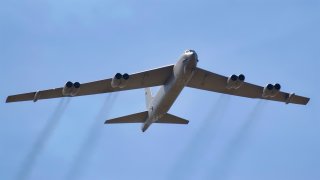B-52: Even at 72 Years Old, This Still Might Be the Best Bomber Ever
The B-52 Stratofortress, a long-range strategic bomber first operational in 1952, remains a vital component of U.S. national security. With 55 active and 15 reserve aircraft, the B-52 plays multiple roles, from strategic attack to maritime operations.
Summary: The B-52 Stratofortress, a long-range strategic bomber first operational in 1952, remains a vital component of U.S. national security. With 55 active and 15 reserve aircraft, the B-52 plays multiple roles, from strategic attack to maritime operations.
-Despite its age, it's been upgraded to carry a diverse array of armaments and participate in modern warfare, evident in recent deployments over Europe, the Middle East, and the Indo-Pacific. The bomber is undergoing modernization, including engine replacements, to extend its service into the 2050s.
-Simultaneously, the Air Force develops the B-21 Raider, ensuring a robust strategic bombing capability into the future.
The Ageless Guardian: How the B-52 Stratofortress Continues to Shape U.S. Air Power
The U.S. military’s aerial fleet still includes an aircraft that began flying shortly after the end of World War Two. The B-52 Stratofortress, one of the main strategic bombers of the U.S. military, first reached initial operating capability in 1952 and entered service in 1961.
Despite its age, the B-52 Stratofortress continues to play an important role in U.S. national security.
72 Years and Going Strong for B-52 Bomber
The B-52 Stratofortress is a long-range strategic bomber that can perform a number of different mission sets, including strategic attack, close air support, air interdiction, offensive counter-air, and maritime operations.
B-52s have participated in pretty much every major military contingency since the Vietnam War. In the past couple of years alone, the Pentagon has deployed B-52s over Europe, the Middle East, and the Indo-Pacific in response to Russian, Iranian, and Chinese aggression.
The strategic bomber also plays an important role in America’s nuclear deterrence. Alongside the B-1 Lancer and B-2 Spirit, the B-52 Stratofortress forms the air component of the U.S. nuclear triad. At various points of the Cold War, the U.S. Air Force flew a B-52 Stratofortress around the clock armed with active nuclear munitions ready for use in the event of a surprise Soviet attack.
Today, the Air Force operates an active fleet of about fifty-five B-52 Stratofortresses, with around 15 more in reserve. In total, 744 B-52s of all variants were built. Currently, the Air Force is flying the H version of the strategic bomber.
The B-52H can carry a payload of 70,000 lbs, including conventional bombs, laser-guided bombs, GPS-guided munitions, mines, air-launched cruise missiles, and nuclear munitions. It has an unrefueled combat range of close to 9,000 miles, and with mid-air refueling it can stay over a target for hours or reach any part of the world.
The aircraft’s advanced targeting pods make it especially deadly. The B-52H can detect, identify, and attack targets night and day, even under extreme weather conditions.
B-52 Modernization and the B-21 Raider
The strategic bomber is currently going through a modernization phase.
In 2021, Rolls Royce got a $2.6 billion contract to replace the aircraft’s aging TF33 engines, which were designed in the 1950s, with new F130 engines. The goal isn’t just to keep the aircraft viable in today’s battlefield, but also to allow it to fly well into the 2050s. If the Air Force goes forward with that plan, the B-52 Stratofortress will be operational for a century.
The Air Force is also looking to replace the B-52’s pylons so that it can carry more hypersonic cruise missiles, thus making the aircraft more effective and increasing its survivability in a potential conflict with China.
But the Air Force isn’t going to rely on the B-52 Stratofortress alone for its strategic bombing missions. In addition to the venerable “Buff,” the Air Force is developing the B-21 Raider, a fifth-generation stealth aircraft that was unveiled in 2022 and is expected to be operational at the end of the decade. The goal is to have a mixed force of B-52s and B-21s to cover the strategic bombing requirements of the U.S. military against near-peer and less capable adversaries.
About the Author
Stavros Atlamazoglou is a seasoned defense journalist specializing in special operations and a Hellenic Army veteran (national service with the 575th Marine Battalion and Army HQ). He holds a BA from the Johns Hopkins University and an MA from the Johns Hopkins’ School of Advanced International Studies (SAIS). His work has been featured in Business Insider, Sandboxx, and SOFREP.


